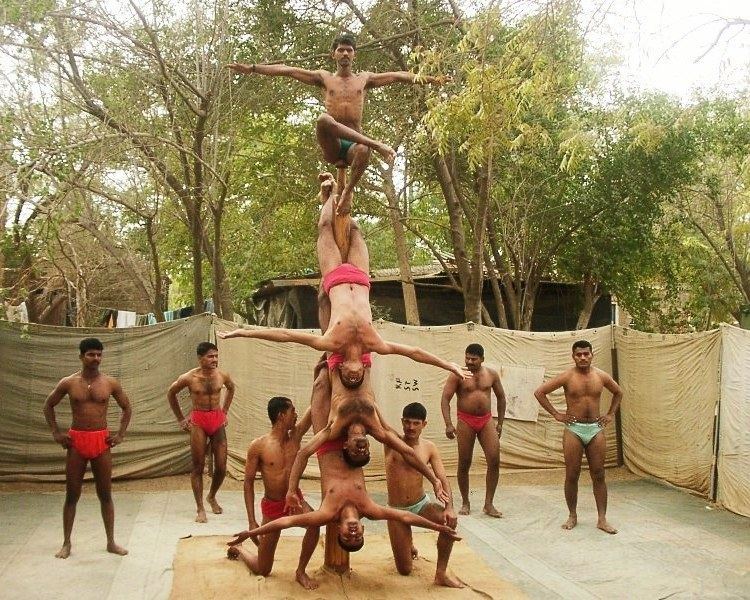 | ||
Mallakhamba (Marathi: मल्लखांब malla-khamba, Tamil: மல்லர் கம்பம் mallar-kambam) is a traditional Indian sport in which a gymnast performs feats and poses in concert with a vertical wooden pole or rope. The word also refers to the pole used in the sport.
Contents
Mallakhamba derives from the terms malla/mallar which denotes a wrestler and khamba/kambam which means a pole. Literally meaning "wrestling pole", the term originally referred to a traditional training implement used by wrestlers. On April 9, 2013, the Indian state of Madhya Pradesh declared mallakhamba as the state sport.
History
The earliest recorded reference to mallakhamba is found in Someshvara Chalukya's classic Manasollasa (1135 AD). Originally mallakhamba was used as a supporting exercise for wrestlers. Although known to have been practiced in medieval Maharashtra and Hyderabad, the sport didn't become visible in practice and well recorded until the 18th century when it was revived by Balambhatdada Deodhar, the fitness instructor of Peshwa Baji Rao II during the reign of the Peshwas. His student Balambhattdada Deodhar realized that only major grips can be developed with a pole and thus used cane instead. Subsequently, the unavailability of cane resulted in rope mallakhamba. Today it is used more often as a performance art rather than a method of training.
As a competitive sport
The Mallakhamb Federation of India is the official Indian National Federation. 29 states of India has participate in mallakhamba competitions at the national level. National level mallakhamba tournaments were first organized more than 25 years ago. The national level tournament is organized in four separate groups according to age.
Official Organizations
All the above organizations were founded by Dr. Jaydeepsinh Jadhav as president, Uday Deshpande as secretary general, Vinayak Rajmachikar as technical committee chairman, Dr. Ashish Mehta as treasurer and Geetanjali Shitole as member.
Types
Almost 25 to 30 types of mallakhamba apparatus were tried and tested over the years. 16 various types are recognized presently, but for sport, only six types are used. Mallakhamba is present in the Hind Kesari, Indian Wrestling championship. Competitively there are three main variations of mallakhamba.
Pole or fixed
In this variation, a vertical wooden pole is fixed in the ground and the participant performs various acrobatic feats and poses while hanging on the pole. Wrestlers mount, dismount and utilize this pole for various complex callisthenics designed to develop their grip, stamina, and strength in the arms, legs and upper-body.
There are a number of pillars, although the most common is a free-standing upright pole, some eight to ten inches in diameter, planted into the ground. The pole used in competitions is a straight pole made of teak or sheesham wood, standing 2.6 metres (8.5 ft) in height with a circumference of 55 centimetres (22 in) at the base. It gradually tapers to a circumference of 35 centimetres (14 in) at the top.
Hanging
The hanging mallakhamba is a wooden pole that is shorter in length than the standard pole and is hung from chain and hooks, leaving a gap between the ground and the bottom of the mallakhamba.
Rope
In this variation, the participant performs exercises while hanging on a rope suspended from a support at the top. Typically the rope is 5.5 mt long, and approximately 1 to 2 cm in diameter. The Rope is caught by the performer in the gap between big toe and the second toe, along with one or both hands. The performer then ties the rope around himself or herself through a sequence of steps, after climbing upwards on the rope. Performer then reaches various positions (Udi), some of which are imitations of standard YogAsanas.
